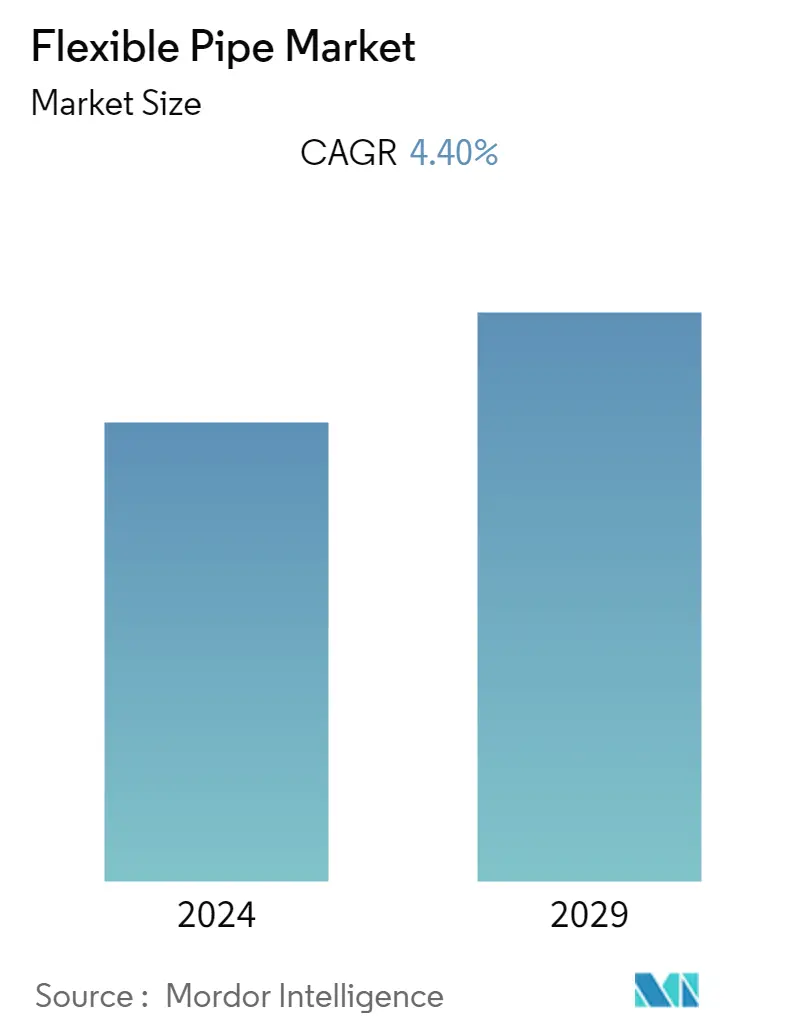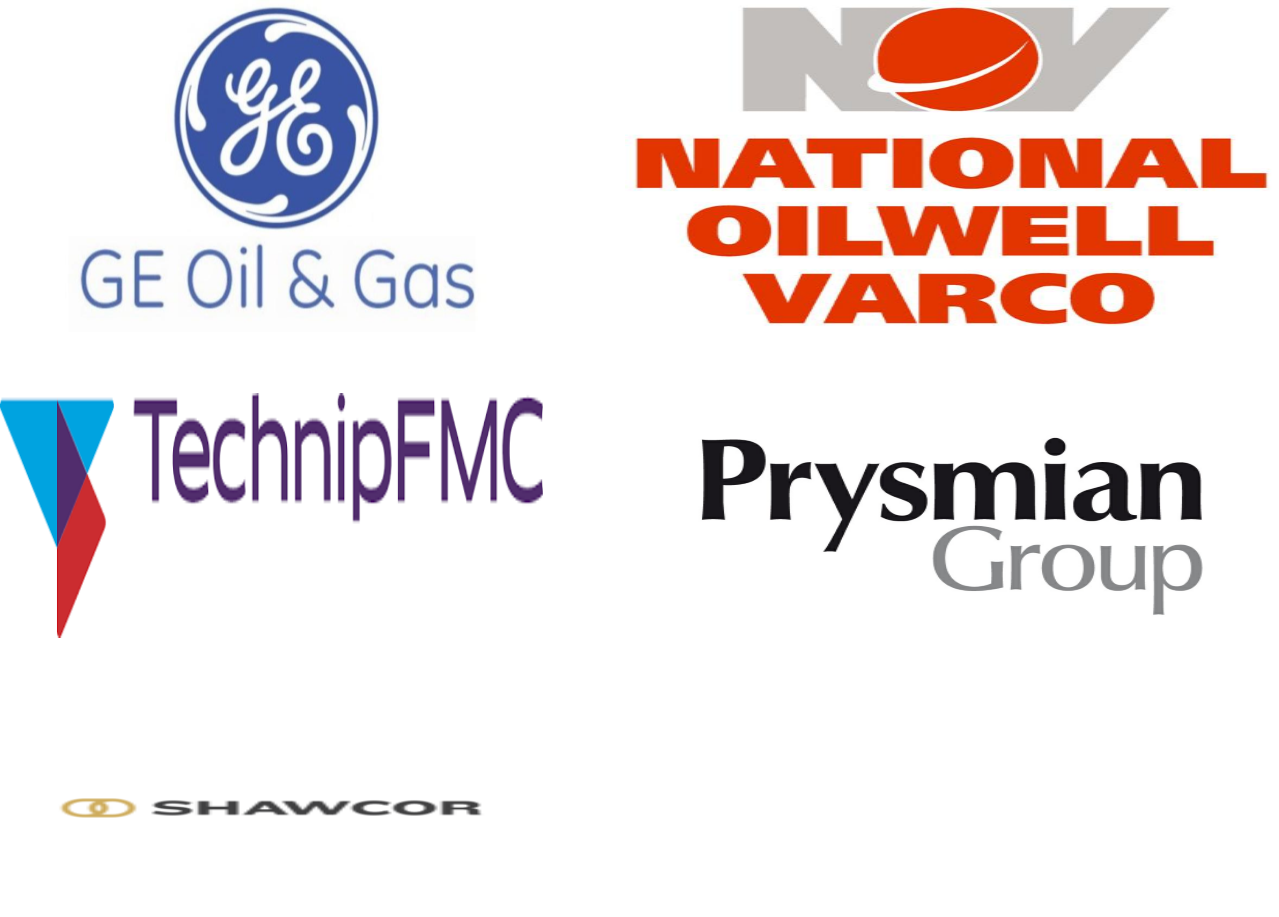Market Size of Flexible Pipe Industry

| Study Period | 2019 - 2029 |
| Base Year For Estimation | 2023 |
| CAGR | 4.40 % |
| Fastest Growing Market | Middle East and Africa |
| Largest Market | North America |
| Market Concentration | Low |
Major Players
*Disclaimer: Major Players sorted in no particular order |
Flexible Pipes Market Analysis
The flexible pipe market was valued at USD 1,012 million in 2020, and it is expected to reach USD 1,308.44 million by 2026, with a CAGR of 4.44%, over the forecast period (2021-2026).
- Flexible pipes and tubes are widely used to transport oils or other liquids from one location to the other, especially through the seabed, or at construction sites and ores. Due to benefits like high-pressure control, lightweight, leak resistance, and lower price, flexible pipes are being used across industry verticals. The technical and cost advantages these pipes offer, are expected to replace the usage of steel equipment for new exploration activities at a greater pace over the forecast period.
- With the ongoing focus of the oil and gas companies on unconventional sources for oil and gas, along with the offshore and subsea developments, which are moving into deeper waters and more challenging environments, there is a need to minimize inspection to reduce cost. Further, the maintenance and repair costs are high. And thus, flexible pipes are found to be the best fit, as they play a key role in increasing the productivity, life-expectancy, and profitability of onshore and offshore wells.
- However, on the flip side, strict restrictions that are imposed to curb the adverse effects on the environment, along with the rigid regulations imposed on oil and gas drilling activities, restrict the growth of the flexible pipe market.
Flexible Pipes Industry Segmentation
The flexible pipelines have been introduced in the areas of floating production, storage, and offloading (FPSO) ships and semisubmersibles. Moreover, the oil and gas, chemical, power generation, and water treatment industries are the key end-use industries of the flexible pipe market. Further, the development of technologies related to the exploration of reserves and oil production, which are currently in the initial stage, is expected to drive the growth of the flexible pipe market.
| By Raw Material | |
| High-density Polyethylene | |
| Polyamides | |
| Polyvinylidene Fluoride | |
| Other Raw Materials |
| By Application | ||||
| ||||
| On shore |
| Geography | |||||||
| |||||||
| |||||||
| |||||||
| |||||||
|
Flexible Pipe Market Size Summary
The flexible pipe market is experiencing growth due to its increasing application in transporting oils and other liquids, particularly in challenging environments such as seabeds and construction sites. The advantages of flexible pipes, including high-pressure control, lightweight, leak resistance, and cost-effectiveness, are driving their adoption across various industry sectors. As oil and gas companies focus on unconventional sources and deeper offshore developments, the need for efficient and cost-effective solutions becomes paramount. Flexible pipes are seen as a viable alternative to traditional steel equipment, enhancing productivity and reducing maintenance costs. However, environmental regulations and restrictions on oil and gas drilling activities pose challenges to market expansion.
In North America, the United States stands out as a significant market for flexible pipes, driven by the country's shale resources and supportive government policies aimed at boosting oil and gas production. The expansion of offshore exploratory drilling is expected to create new opportunities for flexible pipes in the region. The growing demand for oil and gas, fueled by the transport sector and increasing vehicle ownership, further propels the market. The competitive landscape is characterized by key players such as National Oilwell Varco Inc., GE Oil & Gas Corporation, and TechnipFMC PLC, who are focusing on advanced product development and strategic mergers and acquisitions to maintain their market position.
Flexible Pipe Market Size - Table of Contents
-
1. MARKET DYNAMICS
-
1.1 Market Overview
-
1.2 Introduction to Market Drivers and Restraints
-
1.3 Market Drivers
-
1.3.1 Increasing Demand for Non-corrosive Pipes in Oil and Gas Industry
-
1.3.2 Technological Advances in Drilling Process
-
-
1.4 Market Restraints
-
1.4.1 Fluctuating Oil Prices
-
-
1.5 Value Chain / Supply Chain Analysis
-
1.6 Industry Attractiveness - Porter's Five Forces Analysis
-
1.6.1 Threat of New Entrants
-
1.6.2 Bargaining Power of Buyers/Consumers
-
1.6.3 Bargaining Power of Suppliers
-
1.6.4 Threat of Substitute Products
-
1.6.5 Intensity of Competitive Rivalry
-
-
1.7 TECHNOLOGY SNAPSHOT
-
-
2. MARKET SEGMENTATION
-
2.1 By Raw Material
-
2.1.1 High-density Polyethylene
-
2.1.2 Polyamides
-
2.1.3 Polyvinylidene Fluoride
-
2.1.4 Other Raw Materials
-
-
2.2 By Application
-
2.2.1 Offshore
-
2.2.1.1 Deepwater
-
2.2.1.2 Ultra-deepwater
-
-
2.2.2 On shore
-
-
2.3 Geography
-
2.3.1 North America
-
2.3.1.1 United States
-
2.3.1.2 Canada
-
-
2.3.2 Europe
-
2.3.2.1 United Kingdom
-
2.3.2.2 Russia
-
2.3.2.3 Norway
-
2.3.2.4 Italy
-
2.3.2.5 Rest of Europe
-
-
2.3.3 Asia-Pacific
-
2.3.3.1 China
-
2.3.3.2 India
-
2.3.3.3 Malaysia
-
2.3.3.4 Rest of Asia-Pacific
-
-
2.3.4 Latin America
-
2.3.4.1 Brazil
-
2.3.4.2 Argentina
-
2.3.4.3 Rest of Latin America
-
-
2.3.5 Middle East & Africa
-
2.3.5.1 Saudi Arabia
-
2.3.5.2 United Arab Emirates
-
2.3.5.3 Rest of Middle East & Africa
-
-
-
Flexible Pipe Market Size FAQs
What is the current Flexible Pipe Market size?
The Flexible Pipe Market is projected to register a CAGR of 4.40% during the forecast period (2024-2029)
Who are the key players in Flexible Pipe Market?
National Oilwell Varco (NOV), GE Oil & Gas Corporation, TechnipFMC PLC, The Prysmian Group and Shawcor Ltd are the major companies operating in the Flexible Pipe Market.

